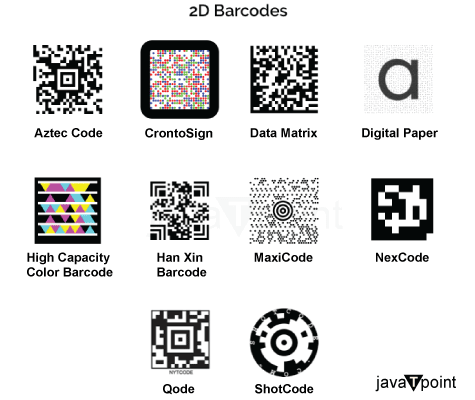What are 2D Barcodes
Barcodes have emerged as a crucial component in these current lives. Even though conventional barcodes, also referred to as linear or one-dimensional(1D) barcodes, have been greatly utilized for a long time, the introduction of two-dimensional(2D) barcodes has marked the beginning of a new age in storing and retrieving data. In this comprehensive exploration, we delve into the realm of 2D barcodes, scrutinizing their characteristics, disparities from 1D barcodes, diverse types, practical applications, and the multitude of advantages they offer.
What is a 2D Barcode?
A 2D (two-dimensional) barcode is a graphical image that stores information both horizontally and vertically. Unlike traditional 1D barcodes, which are composed of vertical black and white lines and have limited data capacity, 2D barcodes offer significantly higher storage capacity. A single 2D barcode can store up to an impressive 7,089 characters, making them ideal for encoding extensive information. Notable examples of 2D barcodes include Data Matrix codes and Quick Response (QR) codes.
Appearance and Scanning
Visually, 2D barcodes differ from 1D barcodes. While 1D barcodes consist of vertical lines, 2D barcodes are composed of black and white dots and shapes, forming intricate patterns. The key distinction lies in the technology required to scan them. Traditional 1D barcodes are often scanned using laser or CCD (charge-coupled device) scanners, whereas 2D barcodes are typically scanned using imaging scanners capable of capturing both 1D and 2D codes.
Types of 2D Barcodes
Numerous types of 2D barcodes have emerged, each designed to meet specific data storage and application needs. Let's explore some common types in more detail

- QR Code (Quick Response Code): QR codes have gained widespread popularity, especially in mobile applications. They can contain various data types, from alphanumeric to binary data, and offer robust error correction capabilities, ensuring accurate data retrieval even when the code is damaged. QR codes have found applications in marketing, product labelling, and contactless payments.
- Aztec Code: Aztec barcodes are space-efficient and resilient, making them suitable for scenarios with limited space or scanner issues. They are commonly used in government documents, airline boarding passes, and ticketing systems.
- Data Matrix: Data Matrix barcodes consist of square modules and can store around 2,000 characters, including alphanumeric and binary data. They are known for their resilience, remaining readable even when damaged. This resilience makes them indispensable in industries such as electronics manufacturing and healthcare.
- PDF417: PDF417 is versatile and can store various binary data types, including images, signatures, and fingerprints. As a result, it finds applications in identity verification, inventory management, and transportation services. Its name, "PDF417," reflects its origins as a "portable document file."
- MaxiCode: Developed by UPS, MaxiCode is used for package tracking and management. It contains information such as invoice numbers, customer references, tracking numbers, and purchase order details. This barcode type ensures efficient logistics and delivery operations.
- GS1 Composite Code: Comprising two components, one at the top and another at the bottom, GS1 Composite codes are often used in grocery stores to encode item identification and additional data like batch codes and expiration dates. They play a crucial role in ensuring food safety and traceability.
Applications of 2D Barcodes
2D barcodes find applications across various industries, demonstrating their versatility and adaptability
- Retail: In grocery stores, 2D barcodes on products can encode information like expiry dates and batch details, reducing product recalls and food wastage. Retailers also use them for contactless payments and loyalty programs.
- Healthcare and Manufacturing: 2D barcodes are used for traceability of pharmaceuticals, medical devices, and small metal components in manufacturing. In healthcare, they enhance patient safety by ensuring accurate medication administration.
- Warehouse and Logistics: Warehouses often receive products with 2D barcodes, simplifying the scanning and retrieval process. Efficient inventory management, order tracking, and timely deliveries are made possible through these codes.
- Pharmaceuticals: 2D barcodes are ideal for small containers, storing information such as serial numbers, batch details, and product descriptions. They enable supply chain transparency and compliance with regulatory requirements.
Benefits of 2D Barcodes
2D barcodes offer a multitude of advantages, making them indispensable in various industries and applications
- Access to Complete Information: A single 2D barcode can provide extensive information, making them valuable in healthcare for accessing patient records, manufacturing for quality control, and logistics for supply chain visibility.
- Inventory Management: With their high data capacity, 2D barcodes are instrumental in tracking identification markers, product categories, timestamps, and more. This level of detail streamlines logistics, reduces errors, and enhances inventory control.
- Marketing Strategies: Organizations leverage 2D barcodes for marketing campaigns and customer engagement. These codes provide a convenient way to share product information, promotions, and links to websites or social media platforms. They are especially effective for mobile marketing, as they can be scanned without internet access.
In conclusion, 2D barcodes have revolutionized data storage and access, offering versatility, resilience, and enhanced information capacity. They have become integral to various industries, driving efficiency, accuracy, and accessibility. As technology continues to advance, the role of 2D barcodes in simplifying our lives and businesses is only set to grow.
|

 For Videos Join Our Youtube Channel: Join Now
For Videos Join Our Youtube Channel: Join Now










